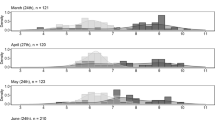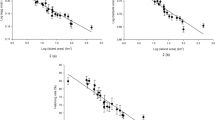Summary
Life history theory suggests that reproductive characteristics such as ovum size and clutch size should be well buffered against vararies of the environment. However, studies which demonstrate environmental sensitivity of reproductive characteristics are increasing in number, as are studies which find that maternal effects are responsible for much of the variation in developmental and growth rates in embryonic and larval fish and amphibians. The data reported here demonstrate that the environment, in terms of temperature and food availability that a specific individual encounters during vitellogenesis, exerts a strong influence on both egg size and number. Warmer temperatures and less food decrease ovum size, while colder temperatures and less food decrease clutch size. The variation in ovum size that is induced by the environment can exert a strong influence on variation in offspring development and growth and serve as an excellent model for studies on the evolution of developmental plasticity.
Similar content being viewed by others
References
Arnold SJ (1981) Behavioral variation in natural populations. I. Phenotypic, genetic and environmental correlations between chemoreceptive responses to prey in the garter snake, Thamnophis elegans. Evol 35:489–509
Bachman K (1969) Temperature adaptations of amphibian embryos. Am Nat 103:115–130
Bagenal TB (1969) Relationship between egg size and fry survival in brown trout Salmo trutta L. J Fish Biol 1:349–353
Berger L, Uzzell T (1977) Vitality and growth of progeny from different egg size classes of Rana esculenta L (Amphibia, Salientia). Zoologica Poloniae 26:291–317
Berven KA (1982a) The genetic basis of altitudinal variation in the wood frog Rana sylvatica. I. An experimental analysis of life-history traits. Evol 36:962–983
Berven KA (1982b) The genetic basis of altitudinal variation in the wood frog Rana sylvatica. II. An experimental analysis of larval development. Oecologia (Berlin) 52:360–369
Blackman RL (1979) Stability and variation in aphid clonal lineages. Biol J Linn Soc 11:259–277
Blaxter JHS (1969) Development: eggs and larvae. In: Hoar WS, Randall BJ (eds) “Fish Physiology”, vol 3. Academic Press, p 177–252
Blaxter JHS, Hempel G (1963) The influence of egg size on herring larvae (Clupea harengus L). Int Council for Explor of the Sea; J du Cunseil 28:211–240
Bradshaw AD (1965) Evolutionary significance of phenotypic plasticity in plants. Adv Genet 13:115–163
Brockelman WY (1975) Competition, the fitness offspring, and optimal clutch size. Am Nat 109:677–699
Brown KM (1985) Intraspecific life history variation in a pond snail: the roles of population divergence and phenotypic plasticity. Evolution 39:387–395
Capinera JL (1979) Qualitative variation in plants and insects: effect of propagule size on ecological plasticity. Am Nat 114:350–361
Caraco T (1980) On foraging time allocation in a stochastic environment. Ecology 61:119–128
Caswell H (1983) Phenotypic plasticity in life-history traits: demographic effects and evolutionary consequences. Am Zool 23:35–46
Cook RE (1975) The photoinductive control of seed weight in Chenopodium rubrum L. Am J Bot 62:427–431
Coombs SH, Hiby AR (1979) The development of the eggs and early larvae of blue whiting, Micromesitius poutassou and the effect of temperature on development. J Fish Biol 14:111–123
Cooper WS, Kaplan RH (1982) Adaptive “coin-flipping”: a decision-theoretic examination of natural selection for random individual variation. J Theor Biol 94:135–151
Crump ML, Kaplan RH (1979) Clutch energy partitioning of tropical tree frogs (Hylidae). Copeia 1979:626–635
Etkin W (1964) Metamorphosis. In: Moore J (ed) Physiology of the Amphbia. Academic Press, pp 427–468
Falconer DS (1981) Introduction to quantitative genetics. Longman, NY
Follett BK, Redshaw MR (1974) The physiology of vitellogenesis. In: Lofts B (ed) Physiology of the Amphibia, vol II, Academic Press, New York, pp 219–308
Fraser DT (1980) On the environmental control of oocyte maturation in a plethodontid salamander. Oecologia (Berlin) 46:302–307
Gall GAE (1974) Influence of size of eggs and age of female on hatchability and growth in rainbow trout. Calif Fish and Game 60:26–36
Gillespie JH (1977) Natural selection for variances in offspring numbers: a new evolutionary principle. Am Nat 111:1010–1014
Gray J (1928) The growth of fish. III. The effect of temperature on the development of the eggs of Salmo fario. J Exp Biol 6:125–130
Gupta AP, Lewontin RC (1982) A study of reaction norms in natural populations of Drosophila pseudoobscura. Evolution 36:934–948
Harper JL, Lovell PH, Moore KG (1970) The shapes and sizes of seeds. Ann Rev Ecol Syst 1:327–356
Heyer WR (1979) Annual variation in larval amphibian populations within a temperate pond. J Wash Acad Sci 69:65–74
Howard RD (1979) Estimating reproductive success in natural populations. Am Nat 114:221–231
Hyman LE, Colot HV, Robash M (1984) Accumulation and behavior of mRNA during oogenesis and early embryogenesis of Xenopus laevis. In: Malacinski M, Klein WH (eds) Molecular Aspects of Early Development. Plenum Press, New York, pp 253–266
Istock C (1984) Boundaries to life history variation and evolution. In: Price PW, Slobodchikoff CN, Gaud WS (eds) A New Ecology. Wiley and Sons, pp 143–168
Jinks JL, Connolly V (1973) Selection for specific and general response to environmental differences. Heredity 30:33–40
Jørgensen CB (1982) Factors controlling the ovarian cycle in a temperate zone anuran, the toad Bufo bufo: food uptake, nutritional state, and gonadotropin. J Exp Zool 224:437–443
Jørgensen CB (1984) Ovarian functional patterns in Baltic and Mediterranean populations of a temperate zone anuran, the toad Bufo viridis. Oikos 43:309–321
Jørgensen CB, Hede KE, Larsen LO (1978) Environmental control of annual ovarian cycle in the toad Bufo bufo bufo (L): Role of temperature. In: Assenmacher I, Farner DS (eds) Environmental Endocrinology. Springer, Berlin, pp 28–36
Jørgensen CB, Larsen LO, Lofts B (1979) Annual cycles of fat bodies and gonads in the toad Bufo bufo bufo (L), compared with cycles in other temperate zone anurans. Det Kongelige Danske Videnskabernes Selskab Biologiske Skrifter 22:5–37
Kaplan RH (1979) Ontogenetic variation in “ovum” size in two species of Ambystoma. Copeia 1979:348–350
Kaplan RH (1980a) The implications of ovum size variability for offspring fitness and clutch size within several populations of salamanders (Ambystoma). Evolution 34:51–64
Kaplan RH (1980b) Ontogenetic energetics in Ambystoma. Physiol Zool 53:43–56
Kaplan RH (1984) Temporal heterogeneity of habitats in relation to amphibian ecology. Second Symposium on Vernal Pools and Intermittent Streams. University of California at Davis, pp 143–153
Kaplan RH (1985) Maternal influences on offspring development in the California newt, Taricha torosa. copeia 1985:1028–1035
Kaplan RH, Cooper WS (1984) The evolution of developmental plasticity in reproductive characteristics: an application of the “adaptive coin-flipping” principle. Am Nat 123:393–410
Kaplan RH, Salthe SN (1979) The allometry of reproduction: an empirical view in salamanders. Am Nat 113:671–689
Kaufman PK, Enfield FD, Comstock RE (1977) Stabilizing selection for pupa weight in Tribotium castaneum. Genetics 87:327–341
Koba K (1937) Ecological observations on the frogs in Manchoukuo (I). Zool Mag (Tokyo) 49:468–477
Kollros JJ (1961) Mechanisms of amphibian metamorphosis. Am Zool 1:107–114
Korotkova EB (1979) Ecology of the orange-bellied toad in the maritime province. Soviet Journal of Ecology 9:391–392 (Transl Ekologiya 9:106–107)
Lacey EP, Real L, Antonovics J, Heckel D (1983) Variance models in the study of life histories. Am Nat 122:114–133
Lehman GL (1978) The effects of four arthropod diets on the body and organ weights of the leopard frog, Rana pipiens, during vitellogenesis. Growth 42:505–518
Levins R (1968) Evolution in changing environments. Princeton University Press, Princeton NJ
Lindsey CC, Arnason AN (1981) A model for responses of vertebral numbers in fish to environmental influences during development. Can J Fish Aquat Sci 38:334–347
Marsh E (1984) Egg size variation in central Texas populations of Etheostoma spectabile (Pisces: Percidae). Copeia 1984:291–301
Marsh E (1986) Effects of egg size on offspring fitness and maternal fecundity in the orangethroated darter, Etheostoma spectabile (Pisces: Percidae). Copeia 1986:18–30
Michael P (1981) A normal table of early development in Bombina orientalis (Boulenger), in relation to rearing temperature. Develop, Growth and Differ 23:149–155
Moore JA (1939) Temperature tolerance and rates of development in the eggs of amphibia. Ecology 20:459–478
Nace G, Ryuzaki M (1971) The care and breeding of Bombina orientalis. Unpublished manuscript
Okada Y (1931) Tailless Batrachians of Japanese Empire. Imperial Agricult Exper Station, Tokyo
Orzack SH (1985) Population dynamics in variable environments. V The genetics of homeostasis revisited. Am Nat 125:550–572
Parker ED (1984) Reaction norms of development rate among diploid clones of the parthenogenetic cockroach Pycnoscelus surinamensis. Evolution 38:1186–1193
Perkins JM, Jinks JL (1971) Specificity of the interaction of genotypes with contrasting environments. Heredity 26:463–474
Petranka JW (1984) Incubation, larval growth, and embryonic and larval survivorship of smallmouth salamanders (Ambystoma texanum) in streams. Copeia 1984:862–868
Phillips PC, Kaplan RH (1987) A personal computer-microscope interface for the analysis of size and shape. Herpetologica (in press)
Pitelka LF, Thayer ME, Hansen SB (1983) Variation in achene weight in Aster acuminatus. Can J Bot 61:1415–1420
Pitman RW (1979) Effects of female age and egg size on growth and mortality in rainbow trout. Prog Fish Culturist 41:202–204
Prout T (1962) The effects of stabilizing selection on the time of development in Drosophila melanogaster. Genet Res 3:364–382
Prout T (1963) The effects of a history of stabilizing selection on sensitivity to foreign environments. Genet Today 1:165 (Abstr)
Real LA (1980) Fitness, uncertainty, and the role of diversification in evolution and behavior. Am Nat 115:623–638
Rendel JM (1967) Canalisation and gene control. Logos, London
Reznick D (1981) “Grandfather Effects”: the genetics of interpopulation differences in offspring size in the mosquito fish. Evolution 35:941–953
Reznick D (1982) Genetic determination of offspring size in the guppy (Poecilia reticulata). Am Nat 120:181–188
Rugh R (1962) Experimental Embryology. Burgess Publ Co, Mineapolis
Salthe SN, Duellman WE (1973) Quantitative constraints associated with reproductive mode in anurans. In: Vial JL (ed) Evolutionary Biology of the Anurans Univ Missouri Press, Columbia, pp 229–249
Schall BA (1980) Reproductive capacity and seed size in Lupinus texensis. Amer J Bot 67:703–709
Schall BA (1983) Life history variation, natural selection, and maternal effects in plant populations. In: Dirzo R, Sarukhan J (eds) Perspectives on Plant Population Ecology. Sinauer, Sunderland, Mass, pp 188–206
Scharloo W (1970) Stabilizing and disruptive selection on a mutant character in Drosophila. III. Polymorphism caused by a developmental switch mechanism. Genetics 65:693–705
Scheiner SM, Goodnight CJ (1984) The comparison of phenotypic plasticity and genetic variation in populations of the grass Danthonia spicata. Evolution 38:845–855
Schmalhausen II (1949) Factors of evolution. Blakiston, Philadelphia
Shapiro AM (1976) Seasonal polyphenism. In: Hecht MK, Steere WL, Wallace B (eds) Evolutionary biology, vol 9. Plenum, New York, p 259–333
Shapiro AM (1982) Redundancy in pierid polyphenisms: pupal chilling induces vernal phenotype in Pieris occidentalis (Pieridae). J Lepidopterists' Soc 36:174–177
Shrode JB, Gerking SD (1977) Effect of constant and fluctuating temperatures on reproductive performance of a desert pupfish, Cyprinodon n nevadensis. Physiol Zool 50:1–10
Smalley KN, Nace GW (1983) Vitellogenic cycles in laboratory-maintained females of the Leopard Frog, Rana pipiens. J Exp Zool 226:211–219
Smith CC, Fretwell SD (1974) The optimal balance between size and number of offspring. Am Nat 108:499–506
Smith-Gill SJ (1983) Developmental plasticity: developmental conversion versus phenotypic modulation. Am Zool 23:47–55
Sokal RR, Rohlf FJ (1981) Biometry. WH Freeman and Co. San Francisco, CA
Stearns S (1976) Life-history tactics: a review of the ideas. Quart Rev Biol 51:3–47
Svardson G (1949) Natural selection and egg number in fish. Rep Inst Freshwater Res Drottingholm 29:115–122
Thompson JN (1984) Variation among individual seed masses in Lomatium grayi (Umbelliferae) under controlled conditions: magnitude and partitioning of the variance. Ecol 65:626–631
Travis J (1981) Control of larval growth variation in a population of Pseudacris triseriata (Anura: Hylidae). Evolution 35:423–432
Travis J (1983) Variation in development patterns of larval anurans in temporary ponds. I. Persistent variation within a Hyla gratiosa population. Evol 37:496–512
Uhlenhuth E (1919) Relation between thyroid gland, metamorphosis, and growth. J Gen Physiol 1:473–482
Via S, Lande R (1985) Genotype-environment interaction and the evolution of phenotypic plasticity. Evolution 39:505–522
Waddington CH, Robertson E (1966) Selection for developmental canalisation. Genet Res 7:303–312
Wibur HM (1977) Propagule size, number, and dispersion pattern in Ambystoma and Asclepias. Am Nat 111:43–68
Author information
Authors and Affiliations
Rights and permissions
About this article
Cite this article
Kaplan, R.H. Developmental plasticity and maternal effects of reproductive characteristics in the frog, Bombina orientalis . Oecologia 71, 273–279 (1987). https://doi.org/10.1007/BF00377295
Received:
Issue Date:
DOI: https://doi.org/10.1007/BF00377295




